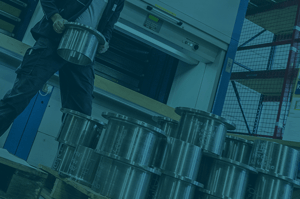We used ceramic coated liners with full satisfaction for many years, but we’ve stopped supplying these for a while due to technical developments. Ceramic coating is still used by a significant number of ships, but ceramic liners are now an outdated method of rotating propeller shaft protection.
We don’t supply ceramic liners any more because technical developments simply presented us with better alternatives. The ceramic coating was applied to chrome steel or cast iron liners in order to keep the lip seals from grooving the liner. You can recognize a ceramic coated liner by its black surface and chrome steel or cast iron liner flange.
Four reasons why we don’t supply ceramic liners anymore:
1. Ceramic has a high (2–5%) porosity value and can become abrasive.
2. It can’t handle damage from abrasive particles, such as sand.
3. Water can intrude under the ceramic surface, creating corrosion of the substrate and the layer delaminates.
4. Ceramic has good insulating properties and heat generated by friction of lip seals and liner cannot be transferred through the ceramic layer. This increases the ageing rate of the lip seal material.
The above reasons combined with extensive research has led to the development of a Hard Metal Layer (HML) for liner protection.
Why it’s smart to apply a Hard Metal Layer (HML) coating on a liner
Extensive research has led to the development of tungsten HML liners. The surface of an HML is harder than ceramic due to the tungsten carbide enhanced layer that is applied by the High Velocity Oxygen Fuel (HVOF) spraying production process.
The lifetime of a liner may be extended up to 20 years (in ideal conditions) depending on the specific operating conditions of the Supreme® seal. Customer experiences show that after 5–10 years of operation, the HML coated liners show virtually no wear.
Compared to ceramic liners, HML liners offer
- improved lifetime of the liner;
- more effective heat transfer, preventing hardening and ageing of the rubber lip seals;
- prevention against corrosion as the HML layer is virtually not permeable by water molecules;
- a porosity of less than 1%;
- no need to pull the shaft or removing the propeller during dry-dock.
However, it’s not required to apply an HML coating to your liner. We also supply chrome steel liners without an HML coating. However, the running surface of a chrome steel liner without coating wears down faster than HML liners. The lip seals leave running tracks and will create grooves on the liner. When these grooves become too deep, leakage can occur. During dry-dock, you have to create a new running surface for the lip seals. This can be done with a distance ring or by machining the liner. With a distance ring the complete seal housing can be shifted, enabling a clean liner running surface for the lip seals.
Protecting liners from wear has always been a challenge. Our dedicated R&D department is continuously working to lengthen the lifetime of our liners. A longer lifetime lowers costs by minimizing seal maintenance and avoiding the need to pull the shaft to replace the liner. Get in touch if you have any questions about our liners or wish to receive a no-obligation proposal.


